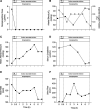Reversal of the Pathophysiological Responses to Gram-Negative Sepsis by Megadose Vitamin C
- PMID: 33239507
- PMCID: PMC7803449
- DOI: 10.1097/CCM.0000000000004770
Reversal of the Pathophysiological Responses to Gram-Negative Sepsis by Megadose Vitamin C
Abstract
Objectives: Oxidative stress appears to initiate organ failure in sepsis, justifying treatment with antioxidants such as vitamin C at megadoses. We have therefore investigated the safety and efficacy of megadose sodium ascorbate in sepsis.
Design: Interventional study.
Setting: Research Institute.
Subjects: Adult Merino ewes.
Interventions: Sheep were instrumented with pulmonary and renal artery flow-probes, and laser-Doppler and oxygen-sensing probes in the kidney. Conscious sheep received an infusion of live Escherichia coli for 31 hours. At 23.5 hours of sepsis, sheep received fluid resuscitation (30 mL/kg, Hartmann solution) and were randomized to IV sodium ascorbate (0.5 g/kg over 0.5 hr + 0.5 g/kg/hr for 6.5 hr; n = 5) or vehicle (n = 5). Norepinephrine was titrated to restore mean arterial pressure to baseline values (~80 mm Hg).
Measurements and main results: Sepsis-induced fever (41.4 ± 0.2°C; mean ± se), tachycardia (141 ± 2 beats/min), and a marked deterioration in clinical condition in all cases. Mean arterial pressure (86 ± 1 to 67 ± 2 mm Hg), arterial Po2 (102.1 ± 3.3 to 80.5 ± 3.4 mm Hg), and renal medullary tissue Po2 (41 ± 5 to 24 ± 2 mm Hg) decreased, and plasma creatinine doubled (71 ± 2 to 144 ± 15 µmol/L) (all p < 0.01). Direct observation indicated that in all animals, sodium ascorbate dramatically improved the clinical state, from malaise and lethargy to a responsive, alert state within 3 hours. Body temperature (39.3 ± 0.3°C), heart rate (99.7 ± 3 beats/min), and plasma creatinine (32.6 ± 5.8 µmol/L) all decreased. Arterial (96.5 ± 2.5 mm Hg) and renal medullary Po2 (48 ± 5 mm Hg) increased. The norepinephrine dose was decreased, to zero in four of five sheep, whereas mean arterial pressure increased (to 83 ± 2 mm Hg). We confirmed these physiologic findings in a coronavirus disease 2019 patient with shock by compassionate use of 60 g of sodium ascorbate over 7 hours.
Conclusions: IV megadose sodium ascorbate reversed the pathophysiological and behavioral responses to Gram-negative sepsis without adverse side effects. Clinical studies are required to determine if such a dose has similar benefits in septic patients.
Copyright © 2020 The Author(s). Published by Wolters Kluwer Health, Inc. on behalf of the Society of Critical Care Medicine and Wolters Kluwer Health, Inc.
Figures





Comment in
-
Is "Mega-Dose" IV Vitamin C Required for Septic and Critical Coronavirus Disease 2019 Patients?Crit Care Med. 2021 Apr 1;49(4):e477-e478. doi: 10.1097/CCM.0000000000004873. Crit Care Med. 2021. PMID: 33731635 No abstract available.
-
The authors reply.Crit Care Med. 2021 Apr 1;49(4):e479-e480. doi: 10.1097/CCM.0000000000004909. Crit Care Med. 2021. PMID: 33731636 No abstract available.
References
-
- Lankadeva YR, Okazaki N, Evans RG, et al. Renal medullary hypoxia: A new therapeutic target for septic acute kidney injury? Semin Nephrol. 2019; 39:543–553 - PubMed
-
- Calzavacca P, Evans RG, Bailey M, et al. Cortical and medullary tissue perfusion and oxygenation in experimental septic acute kidney injury. Crit Care Med. 2015; 43:e431–e439 - PubMed
MeSH terms
Substances
LinkOut - more resources
Full Text Sources
Other Literature Sources
Medical

